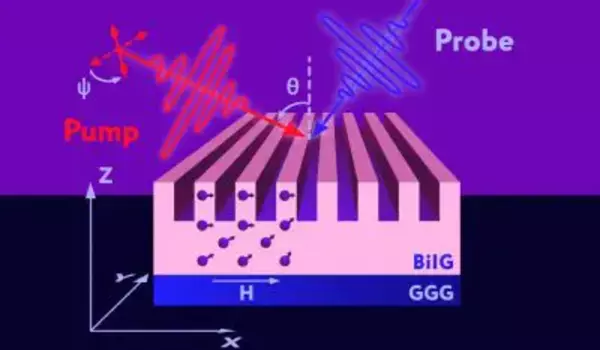Magnonic computing is a cutting-edge research topic that investigates the possibility of employing spin waves, also known as magnons, as information carriers in innovative computer systems. Unlike traditional electronic computing, which relies on electron movement to transfer and process information, magnonic computing uses electrons’ intrinsic rotational momentum, or spin, to transmit and alter data.
As excellent, electron-based systems have limitations, research is being conducted around the world to find alternatives to our existing electronic computing technology. The field of magnonics is developing a new method of conveying information: instead of electron exchange, the waves generated in a magnetic medium might be used for transmission, however, magnonics-based computing has proved (too) slow to date. Scientists have identified a key new method: increasing the intensity causes the spin waves to grow shorter and faster – another step toward magnon computing.
As excellent, electron-based systems have limitations, research is being conducted around the world to find alternatives to our existing electronic computing technology. The field of magnonics is developing a new method of conveying information: instead of electron exchange, the waves generated in a magnetic medium might be used for transmission, however, magnonics-based computing has proved (too) slow to date. Scientists at the University of Vienna have identified a major new method: increasing the intensity causes the spin waves to grow shorter and faster – another step toward magnon computing. The findings have been published in the journal Science Advances.
Imagining the approach with light is useful. The color of light changes as its wavelength changes. When you vary the intensity, however, simply the brightness changes. We discovered a way to modify the hue in this situation by varying the intensity of the spin waves. We were able to excite much shorter and better spin waves as a result of this phenomenon.
Andrii Chumak
Magnonics is a relatively recent topic of magnetism research. Spin waves are important because a local disruption in a magnet’s magnetic order can propagate as waves through a material. These are known as spin waves, and the related quasiparticles are known as magnons. They transmit data in the form of angular momentum pulses. Because of this feature, they can be employed as low-power data carriers in future computers that are smaller and more energy-efficient. The fundamental difficulty with magnonics is the wavelength. The slower magnon-based data processing units are, the larger it is.
Until date, only very complicated hybrid structures or a synchrotron could shrink the wavelength. A simpler alternative has been developed by the University of Vienna’s research group “Nanomagnetism and Magnononics” in collaboration with colleagues from Germany, the Czech Republic, Ukraine, and China. After months of effort in the Brillouin light scattering spectroscopy laboratory at the University of Vienna’s Faculty of Physics, first author Qi Wang made the critical discovery: increasing the intensity causes the spin waves to become shorter and faster – a breakthrough method for magnonic computing.

Andrii Chumak, co-author of the paper and leader of the Vienna NanoMag team, uses a metaphor to illustrate the discovery: “Imagining the approach with light is useful. The color of light changes as its wavelength changes. When you vary the intensity, however, simply the brightness changes. We discovered a way to modify the hue in this situation by varying the intensity of the spin waves. We were able to excite much shorter and better spin waves as a result of this phenomenon,” Chumak explained.
The current wavelength discovered by this method is around 200 nanometers. According to computer calculations, it is feasible to excite even smaller wavelengths, however it is extremely difficult to excite or detect these orders of magnitude at current time.
The spin wave amplitudes are also important for future magnetic integrated circuits. The system discovered has a self-locking nonlinear shift, which means that the amplitude of the excited spin waves is constant. This characteristic is important for integrated circuits because it allows different magnetic elements to operate at the same amplitude. This, in turn, is critical to the development of increasingly complicated systems and the fulfillment of the far-off aim of a magnon-based computer. The ultimate goal of creating a fully functional magnon computer has yet to be realized. Nonetheless, this significant milestone takes researchers much closer to their aim.













